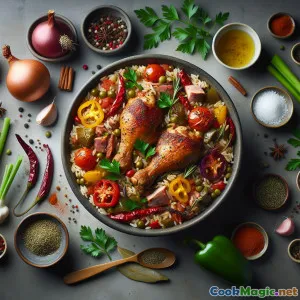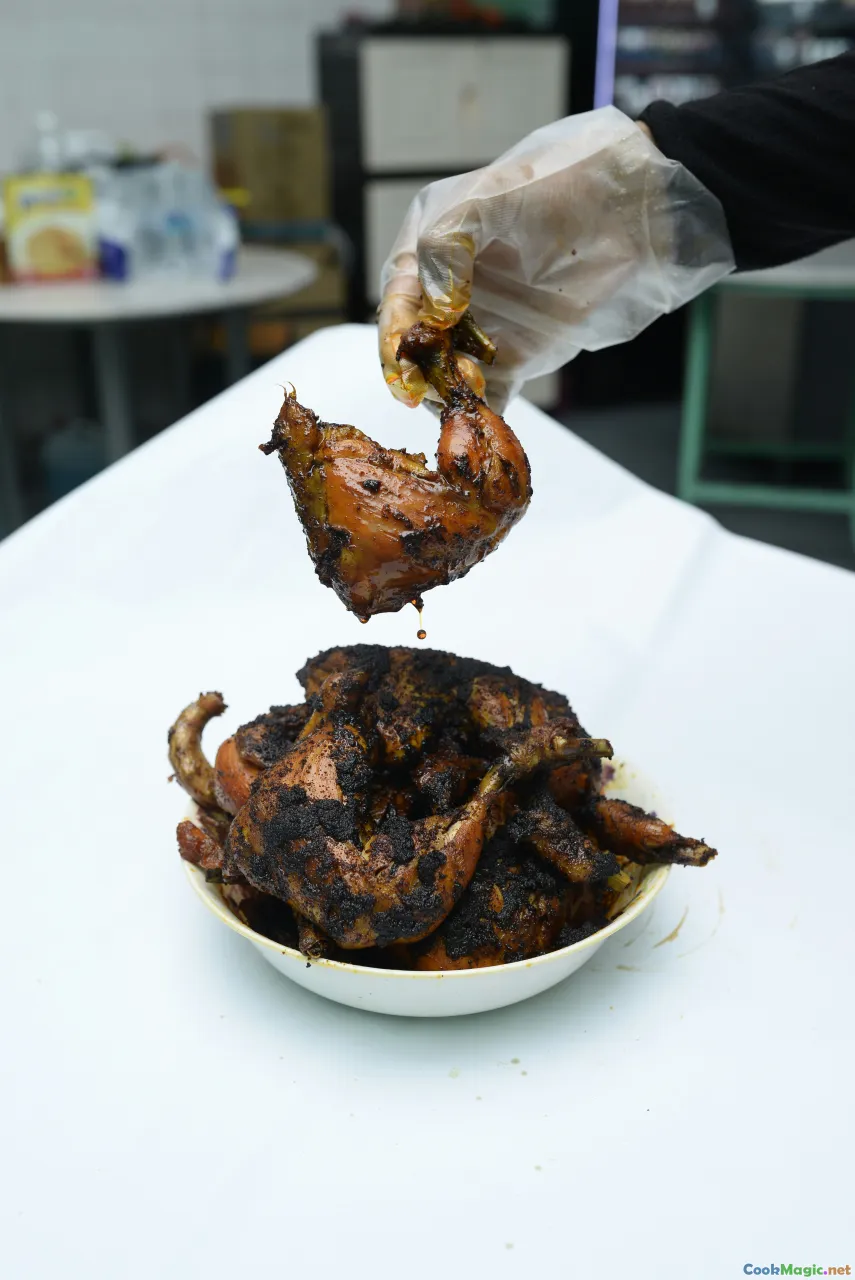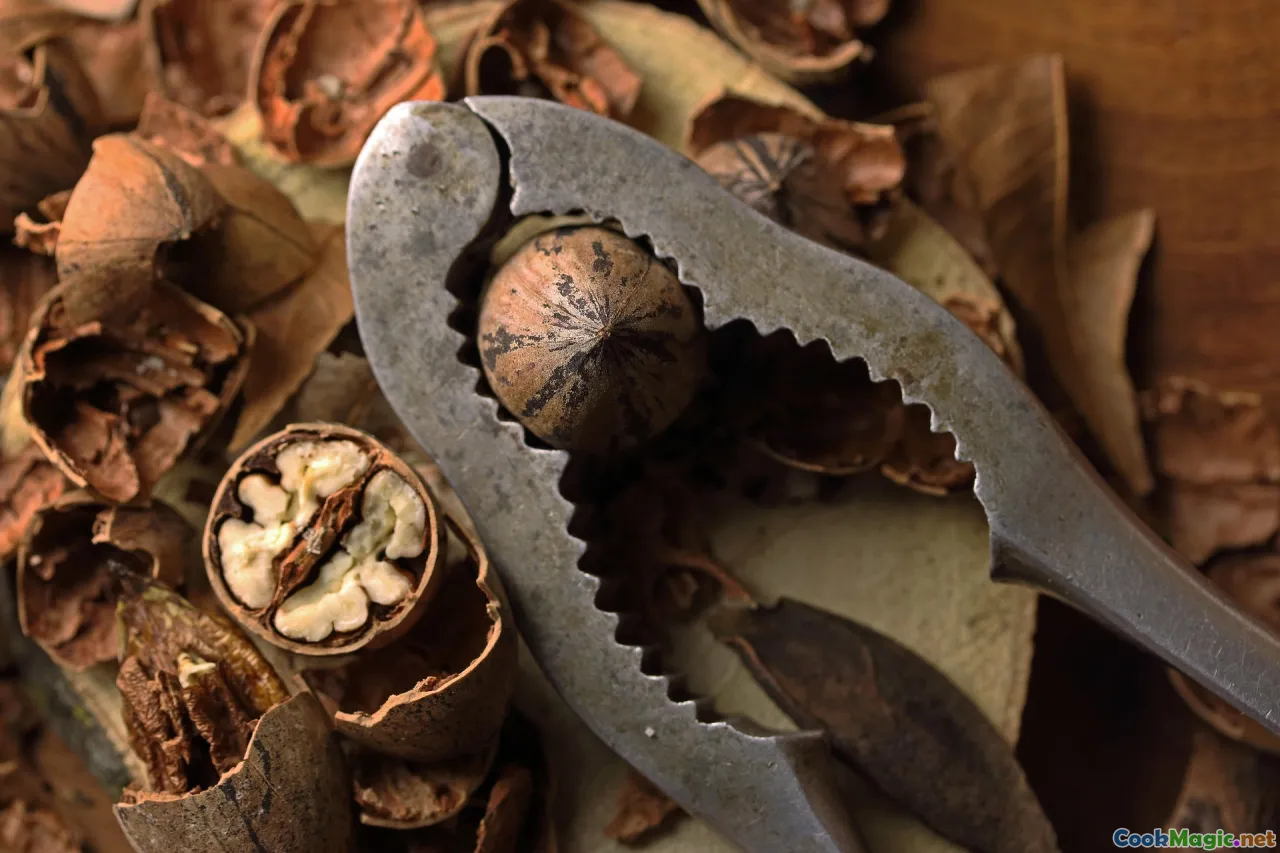
피칸 훈제 치킨 & 타소 잠발라야 축제
(Pecan Smoked Chicken & Tasso Jambalaya Fiesta)
(0 리뷰)재료
-
1.2 kg 뼈 있는 피부 없는 닭 허벅지
(선호하신다면 닭 가슴살로 대체하세요.)
-
2 cups 피칸 나무 조각
(닭고이를 훈제하려면 히코리 목재를 사용하세요. 구할 수 없으면 다른 목재를 사용하십시오.)
-
250 grams 타소 햄
(안두아이 소시지는 대체재로 사용할 수 있습니다.)
-
350 grams 장립 쌀
(생으로, 깨끗이 씻으세요.)
-
900 ml 치킨 육수
(저나트륨이 가장 좋습니다.)
-
2 each 피망 (빨강 & 초록)
(주사위 모양으로 자른)
-
3 each 셀러리 줄기
(다진)
-
1 large 노란 양파
(잘게 썬)
-
4 each 마늘 쪽
(다진)
-
400 grams 캔에 든 잘게 썬 토마토
(1캔, 물기를 빼지 않음)
-
1 tbsp 훈제 파프리카
-
0.75 tsp 카이엔 페퍼
(맵기 정도를 기호에 맞게 조절하세요)
-
1.5 tsp 말린 타임
-
2 each 월계수 잎
(전체)
-
2 tsp 소금
-
1.5 tsp 흑후추
-
2 tsp 핫 소스
(루이지애나 스타일, 또는 취향에 따라)
-
3 each 파
(얇게 썬 것, 장식용)
-
2 tbsp 평잎 파슬리
(다진, 장식용)
-
3 tbsp 올리브 오일
(볶음용)
(선호하신다면 닭 가슴살로 대체하세요.)
(닭고이를 훈제하려면 히코리 목재를 사용하세요. 구할 수 없으면 다른 목재를 사용하십시오.)
(안두아이 소시지는 대체재로 사용할 수 있습니다.)
(생으로, 깨끗이 씻으세요.)
(저나트륨이 가장 좋습니다.)
(주사위 모양으로 자른)
(다진)
(잘게 썬)
(다진)
(1캔, 물기를 빼지 않음)
(맵기 정도를 기호에 맞게 조절하세요)
(전체)
(루이지애나 스타일, 또는 취향에 따라)
(얇게 썬 것, 장식용)
(다진, 장식용)
(볶음용)
영양 정보
- 인분: 6
- 1인분 크기: 1 그릇 (300g)
- Calories: 610 kcal
- Carbohydrates: 0 g
- Protein: 37 g
- Fat: 26 g
- Fiber: 5 g
- Sugar: 7 g
- Sodium: 1500 mg
- Cholesterol: 120 mg
- Calcium: 88 mg
- Iron: 3.1 mg
조리법
-
1 - 피칸 나무로 닭고기를 훈제하라:
스모커를 130°C (266°F)로 예열합니다. 피칸 나무 칩을 30분간 담가 두고 물기를 빼십시오. 닭다리 살은 소금과 흑후추로 가볍게 간합니다. 간접 열 위에 놓고 피칸 칩으로 50-60분간 훈제하여 속까지 거의 익도록 합니다. 꺼내 10분 쉬게 한 후 고기를 주사위 모양으로 자릅니다.
-
2 - 브라운 타소 햄:
닭고기가 쉬는 동안 중불로 달군 더치 오븐에 올리브유 1큰술을 두릅니다. 타소 햄 큐브를 넣고 3–4분간 노릇노릇해질 때까지 볶아 주세요. 꺼내 한쪽에 둡니다.
-
3 - 볶은 채소:
필요에 따라 올리브 오일을 추가하십시오; 양파, 피망, 셀러리를 5-6분간 부드러워질 때까지 볶습니다. 다진 마늘을 넣고 향이 올라올 때까지 2분 더 요리합니다.
-
4 - 잠발라야 베이스 만들기.:
큐브 토마토(주스 포함), 월계수 잎, 훈제 파프리카, 타임, 카이엔 고추를 넣으세요. 타소를 다시 팬에 올려 놓고 향이 나오도록 2분 더 볶으세요.
-
5 - 쌀과 양념을 추가하세요:
쌀을 넣고 고루 섞어 알갱이에 양념이 고이도록 합니다. 소금과 흑후추를 뿌립니다.
-
6 - 육수와 함께 끓이기:
닭 육수를 붓고 센 불에서 끓기 시작할 때까지 올려 두십시오. 뚜껑을 덮고 불을 약하게 줄여 약 35–40분 정도 가끔 저어가며 쌀알이 겨우 부드러워지고 대부분의 액체가 흡수될 때까지.
-
7 - 마무리 및 서빙:
다진 훈제 닭고기를 살살 접어 넣으세요. 뚜껑을 덮지 않은 채 5-8분간 약한 불로 끓여 주세요. 간을 맞추고, 필요하면 매운 소스를 넣어 저으세요. 잠발라야를 뜨겁게 제공하고, 대파와 파슬리로 장식하세요.
스모커를 130°C (266°F)로 예열합니다. 피칸 나무 칩을 30분간 담가 두고 물기를 빼십시오. 닭다리 살은 소금과 흑후추로 가볍게 간합니다. 간접 열 위에 놓고 피칸 칩으로 50-60분간 훈제하여 속까지 거의 익도록 합니다. 꺼내 10분 쉬게 한 후 고기를 주사위 모양으로 자릅니다.
닭고기가 쉬는 동안 중불로 달군 더치 오븐에 올리브유 1큰술을 두릅니다. 타소 햄 큐브를 넣고 3–4분간 노릇노릇해질 때까지 볶아 주세요. 꺼내 한쪽에 둡니다.
필요에 따라 올리브 오일을 추가하십시오; 양파, 피망, 셀러리를 5-6분간 부드러워질 때까지 볶습니다. 다진 마늘을 넣고 향이 올라올 때까지 2분 더 요리합니다.
큐브 토마토(주스 포함), 월계수 잎, 훈제 파프리카, 타임, 카이엔 고추를 넣으세요. 타소를 다시 팬에 올려 놓고 향이 나오도록 2분 더 볶으세요.
쌀을 넣고 고루 섞어 알갱이에 양념이 고이도록 합니다. 소금과 흑후추를 뿌립니다.
닭 육수를 붓고 센 불에서 끓기 시작할 때까지 올려 두십시오. 뚜껑을 덮고 불을 약하게 줄여 약 35–40분 정도 가끔 저어가며 쌀알이 겨우 부드러워지고 대부분의 액체가 흡수될 때까지.
다진 훈제 닭고기를 살살 접어 넣으세요. 뚜껑을 덮지 않은 채 5-8분간 약한 불로 끓여 주세요. 간을 맞추고, 필요하면 매운 소스를 넣어 저으세요. 잠발라야를 뜨겁게 제공하고, 대파와 파슬리로 장식하세요.
피칸 훈제 치킨 & 타소 잠발라야 축제 :에 대한 자세한 정보
Introduction
Pecan Smoked Chicken and Tasso Jambalaya is a celebration of deep, Southern sensibilities married elegantly to classic Cajun cuisine with a smoky, aromatic twist. Born from the Louisiana bayou’s melting pot, jambalaya is the region’s iconic one-pot feast, traditionally brimming with a mixture of meats, smoked sausages, vegetables, and rice. Its origins trace back to Spanish paella, adapted over centuries by local cooks into a uniquely American favorite.
This version intensifies the beloved jambalaya experience: slow-smoked chicken thighs over pecan wood infuse a gentle, nutty aroma into each bite, while Cajun-spiced tasso ham punches up the dish’s savory base. Bright peppers and the trinity of onions, celery, and garlic introduce depth, and boldly seasoned long-grain rice ties it all together. Warm spices such as smoked paprika, cayenne, and thyme anchor those earthy Southern undertones, while fresh green onions and parsley liven up the finish – making every spoonful complex yet comforting.
Unique Aspects
The pecan wood smoke utterly transforms traditional jambalaya. Rather than defaulting to oven roasting, deploying a smoker channels the renowned barbecue magic Southern cooks prize, imbuing the chicken with a delicate smokiness and subtle pecan-rich nuance. This extra step creates outstanding aroma while keeping the chicken deliciously juicy. Tasso, a spiced and cured Cajun ham cut, delivers a concentrated garlic-chile heat and distinctive flavor. If unavailable, andouille sausage will step in well, though authentic tasso radiates an unmistakable Cajun soul.
Rice, essential to any jambalaya, soaks up every flavor sponge-like, holding earthy smokiness in its grains. And because the dish is traditionally one-pot, cleanup is easy and all the goodness melds in together: savory smoked meats, perfectly stewed vegetables, spiced broth and bright garnishes striking just the right note of freshness. Louisiana hot sauce brings optional bracing fire for those habitually craving heat.
Cultural Significance & History
Jambalaya hails from New Orleans’ unique tapestry: rice and spice influenced by West African, French, Spanish, and Indigenous cooks who each contributed elements to early Creole kitchens. Paella’s format migrated from Spain, but affordability and availability of local ingredients prompted the Southern transformation – smoked meats, long-grain rice, and the so-called "trinity" of vegetables. What distinguishes Cajun from Creole jambalaya is both the addition (Cajun often omits tomatoes in favor of a pure meat-and-broth base) and the layering of spice. Serving jambalaya at large gatherings expresses hospitality and heart: it’s as much a community ritual as it is a meal.
Tips & Notes
- Smoking Matters: True smoky flair hinges on keeping pecan chips moist (soak before use), steady moderate heat, and patience. Don't rush – allow chicken to take on both color and flavor, and let it cool a bit before dicing.
- Rice Watching: Be vigilant as the rice finishes. Too much stirring can make rice sticky; careful folding lends distinct grains. If it looks a bit dry toward the end, add a splash of chicken broth and cover.
- Vegetable Power: Feel free to ramp your bell pepper count, add okra, or try yellow instead of white onion for extra sweetness. Jalapeños bring another flavor layer for the heat-chasers.
- Make-Ahead: This jambalaya keeps well – flavors deepen overnight in the fridge. Leftovers reheat beautifully in a skillet with a dash of broth to loosen.
- Substitutions: If tasso is unavailable, lean smoked bacon or chunked andouille will fit the flavor bill.
Personal Thoughts
While I wasn’t born in the Louisiana bayou, each spoonful of this dish conjures memories of Southern kitchens: laughter, huge steaming pots on the stove, and relatives crowded around picnic tables. Pecan Smoked Chicken and Tasso Jambalaya is food that brings people together across backgrounds, just as its own ingredients hail from varied cultures and cuisines. It’s equal parts bold and elegant, smoky and fresh – and an exceptionally rewarding adventure for any cook ready to dedicate a little extra time to something unforgettable.
























